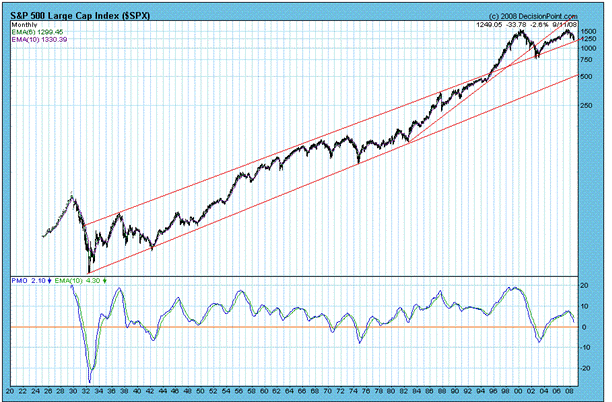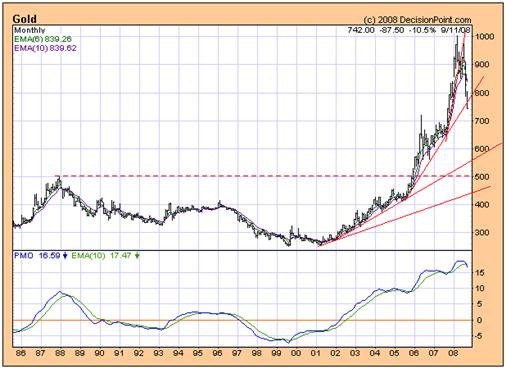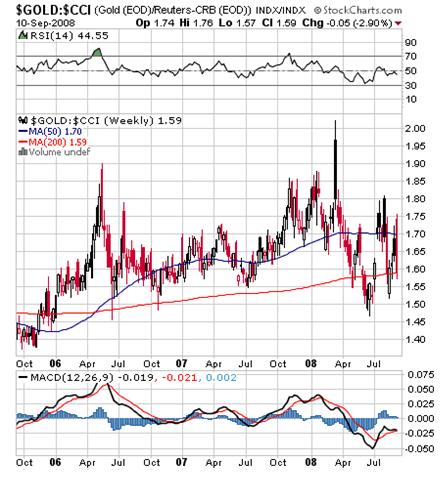Equity and Commodity Markets Dichotomy of Sanity
Stock-Markets / Financial Markets Sep 12, 2008 - 07:00 AM GMTBy: Brian_Bloom
 One dictionary meaning of the word “dichotomy” is: “Division into two usually contradictory parts or opinions”. Alternatively: “being twofold; a classification into two opposed parts or subclasses.”
One dictionary meaning of the word “dichotomy” is: “Division into two usually contradictory parts or opinions”. Alternatively: “being twofold; a classification into two opposed parts or subclasses.”
It has been this analyst's experience that truly sane people are those who sometimes display symptoms of what appears to be insanity. One cannot appreciate light unless one has experienced dark. One cannot appreciate happiness unless one has experienced sadness. No one can be truly sane unless he experiences flashes of insanity. It's a question of degree.
What has this esoteric concept got to do with investment?
Just as all of life manifests as cycles of energy, so economic activity manifests cyclically. The US Federal Reserve and the bankers thought that they could “control” that which is essentially the manifestation of a force of nature – the economic cycle. The thought that one can arrange for the economy to breathe only in, and never out, is like arguing that the lungs can be controlled never to expire. Such a concept is not only insane, it is ridiculous. Markets may be an invention of humans, but human behaviour is not an invention of humans. We cannot legislate against fear and/or hope.
The reader is invited to examine the 80 year chart below (Source: decisionpoint.com). What is remarkable about this chart is how far the price of the Standard and Poor Industrial Index has levitated from the lower of the two parallel rising trend lines.

Logically, this scenario can only culminate in one of three ways – and I invite you to think of that pair of lungs whilst you are reading what follows:
- The lungs just keep on expanding until barotrauma eventually manifests and the lungs explode. This would most probably result in the death of the patient. The economy would be destroyed – never to recover.
- The lungs, like those of an underwater diver who has been holding his breath without exhaling any air, will suddenly contract, and there will be an outward rushing of air. The economy will contract (and the equity markets with it) until the $SPX bounces up from the lower trend line – somewhere around the 550 – 700 level, depending on the speed of contraction. This implies there is a potential for anything up to a 50% fall from current levels.
- The lungs contract calmly as the underwater diver allows bubbles of air to slowly escape in a controlled manner, and the $SPX travels sideways in a trading range for between 15-20 years before it finally comes into contact with (or in close proximity to) the lower rising trend line preparatory to expanding naturally once again.
My personal opinion is that the latter option is the most reasonable outcome. My mind cannot embrace the concept that we “might” be in a Primary Bull market and we that we “might” be experiencing a technical downward reaction in that Bull Market. This concept is so off-the-wall ridiculous in context of the cyclical nature of breathing in and breathing out, that it is not even open for discussion. Could it happen? Well, if pigs could fly I suppose it could.
What I am seeing in the above chart is:
- A market that has been “ramped” too far above its lower trend line by moronic central bankers who have deluded themselves into believing they are God-like and can control nature. Alan Greenspan was not a genius. You can draw your own conclusions as to what was motivating his decisions. Your guess is as good as anyone else's.
- A technical pattern known as a “Double Top” – where “The market” has said: “Enough! If this carries on any further the financial system will be destroyed”
- A downward pointing PMO Oscillator which is also manifesting falling tops. This indicates to me that the economic lungs are going to expire – hopefully slowly if our central bankers come to understand the dichotomy of sanity. If they do, then they will acknowledge the previous insanity of their ways and stop trying to pump up the economy by printing ever greater amounts of money.
As sure as night follows day, recession will follow boom. The question is one of duration. If the recession is “short and sharp” what will likely follow is a “depression” and significant and sharp pain for many. The alternative is that the pain can be managed – via the infusion of a sort of economic analgesic – and the pain will be reduced to long term discomfort for many.
The wild cards – or the jokers in the pack - are “ China ” and India . Historically, the driver of the world economy has been the emergence of new energy technologies. When the then existing markets for products and services based on the new technologies became saturated, the world economy exhaled until the emergence of new technologies – based on yet another new energy paradigm – facilitated a reflation of the world economy and the next inhalation.
The reason China and India are wild cards is that, with their emergence as players in the world economy, the size of the markets for the old technologies has increased.
But, along with this increase in market size, has emerged a threat to the planet's environment. If we thought that our atmosphere was contaminated when one billion people were actively spewing industrial pollution, what do we think will happen when 5 billion people are actively spewing industrial pollution?
It follows that the new energy paradigm must have characteristics which do not result in pollution. This cannot be said of nuclear fission. Nuclear fission is therefore unacceptable as an alternative energy paradigm.
Conceptually, the new energy paradigm will have to be based on a pairing of two unrelated technologies. One of these technologies will “scavenge” energy from the environment, and the other will be based on “storing” this scavenged energy. Contenders for this scavenged source of energy are:
- Solar
- Wind
- Hydro Electric
- Geothermal
- Ocean Waves
- Dark energy in the Universe
I happen to believe that this latter source – which may be the harbinger of over-unity energy generating machines – may hold an important key to the future. Yes, I know that this view appears to fly in the face of the laws of thermodynamics, and that there will be mainstream scientists out there who regard my thoughts as potentially insane. My response to those scientists is that there is a dichotomy to sanity – which is why I have chosen to take this approach to introducing this article. Before Einstein came along, Newton was king. Doubtless, someone will come along who will render the laws of thermodynamics a subset of some other overarching laws of physics – yet to be discovered – just as Newtons laws of gravity became a subset of the larger whole. Anyone who is fixated on the idea that such a development is impossible needs to reflect on his own sanity. The historical evidence is overwhelmingly against your prejudicial viewpoint. You cannot just ignore this evidence of human evolution just because it makes you uncomfortable. Additionally, there is an emerging wave of individual inventors who are claiming to have been enjoying some results in their efforts to harness electromagnetic energy from the environment.
As mentioned, the second (twin) technology that will need to be paired with the energy scavenging technology will need to be an energy storage technology. One needs to bear in mind that energy can be described in terms of “calories” or “joules” or “btu's”. With this mindset, fossil fuels can be thought of as nature's way of storing joules. There are other ways.
Contenders for this storage technology to be coupled with the scavenging technology are:
- Chemically based (electro chemical reactions which release joules). One of the most promising of these appears to be a technology called “EEStor” Quote: “The company expects its ceramic ultracapacitor, which it said uses no hazardous materials, to have a charging time of 3 to 6 minutes, with a discharge rate of only 0.02 percent over 30 days. EEStor said that compares to more than 3 hours to charge a lithium-ion battery and a discharge rate of 1 percent over 30 days.” Source: http://media.cleantech.com/3174/eestors-weir-speaks-about-ultracapacitor-milestone )
- Hydrogen, which can be produced by splitting the water molecule into its elemental components. Currently hydrogen is an energy “sink” – i.e. it takes more energy to produce hydrogen than can be stored in the hydrogen produced. However, if coupled with energy scavenging technologies, the concept of an energy sink is rendered less relevant. Environmental energy is free. It is the production and maintenance of the equipment to harness this energy that will have a cost and the question will revolve around cost per joule produced per second (watts of energy) relative to the current costs of generating watts by burning coal and oil – of around 5 – 10 cents per Kw Hour. Conceptually, energy from wind and/or solar can be used to produce hydrogen when the sun shines and/or the wind blows and the hydrogen can be stored for later usage – either by burning it or running it through a fuel cell. This is already being achieved. See: http://de.youtube.com/watch?v=xEdQRVQtffw
- Superconductive materials
Up to now, the most likely contenders in this latter category have been based on “rare earth” elements. Relatively recently, however, a new and exotic method of creating superconductive materials has emerged – where the atomic structure of conventional noble metals is modified and the resulting non-metallic material becomes electrically superconductive in the process. Essentially, this is achieved by rearranging the shape/angle/relative positions of the orbits of the electrons that revolve around the atom's nucleus. To quote from the patent registration document: “electron rearrangement between the d and s orbitals” Source: http://www.rexresearch.com/ormes/ormes.htm
One of the most powerful of these materials – the one that becomes amongst the most electrically superconductive as a result of this modification – is gold.
That, essentially, is one reason I am long term bullish on gold. But, to be realistic, we may be decades away from commercialising the production of this material. For one thing, the methodology has been patented, and the inventor does not appear to be driven by a need to acquire vast sums of money.
Nevertheless, the charts will eventually send us the message as to when the markets have begun to recognise this amazing property of the gold powder – which appears also to be linked to its resonance with DNA.
Right now, Gold is still behaving like any other commodity and the price of commodities is exhaling along with prices on other markets – as can be seen from the chart below (Source: Decisionpoint.com)

The gold price on the monthly chart has penetrated below its rising trend line and the PMO oscillator is pointing down – having penetrated below its moving average line. This is not a bullish chart.
Further, the relative strength chart (the ratio of the gold price to the commodities index) has essentially been moving sideways for three years and now looks like it wants to weaken slightly in relative terms. (Chart courtesy Stockcharts.com)

It follows that, if commodities (including oil) are going to pull back in price, then so will gold.
The chart below of the commodities index (courtesy decisionpoint.com) is moderately more bullish than the gold price chart in that it has not yet penetrated the trend line on the downside, but its PMO oscillator is also looking vulnerable.

Conclusion
Whilst the Chinese and Indian economies are the jokers in the pack, the US equity market and the world's commodities markets are all looking fairly vulnerable. On balance, it appears that the world economy is looking to exhale after years of being artificially inflated by the central bankers' monetary pumps.
The good news is that, whilst the ecological environment has become increasingly threatened as a result of the entry of China and India into the economic fray (and the incremental pollution that has resulted) there are technologies coming down the turnpike that look like they will be both economically stimulative and environmentally benign.
The world will continue to turn, and those of us who behave prudently will likely come out of this reasonably intact. The concept of prudence in our approach is more fully explored in my recently published factional novel, Beyond Neanderthal .
By Brian Bloom
You may now order your copy of Beyond Neanderthal from www.beyondneanderthal.com . My guess is that we will both be glad you did. The feedback from readers has been very positive, and I am grateful for that. Via its light hearted storyline, the novel points a direction as to what we should be doing in the event that global cooling starts to manifest; and it also sows some seeds of ideas on how we might defuse the clash of civilisations
Copyright © 2008 Brian Bloom - All Rights Reserved
Disclaimer: The above is a matter of opinion provided for general information purposes only and is not intended as investment advice. Information and analysis above are derived from sources and utilising methods believed to be reliable, but we cannot accept responsibility for any losses you may incur as a result of this analysis. Individuals should consult with their personal financial advisors.
Brian Bloom Archive |
© 2005-2022 http://www.MarketOracle.co.uk - The Market Oracle is a FREE Daily Financial Markets Analysis & Forecasting online publication.



